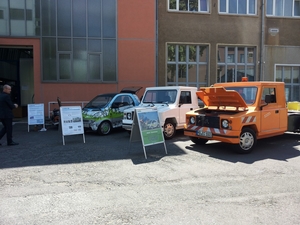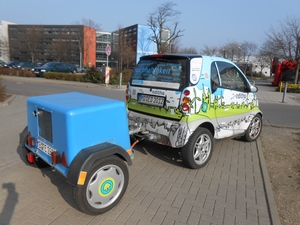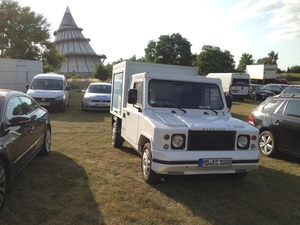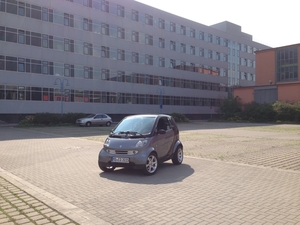Scientific news ticker july 2015
Trial Platform for Operating Strategies of Range Extenders / E-Mobility

July 2015 Given a sufficient power source, electrically driven vehicles might well be an equal if not superior alternative to conventionally driven ones. The proper elimination of existing disadvantages in electric vehicles on a medium-term basis will prove decisive when assessing their chances for future success. In the course of the research project ELISA “Modular Light Constructional Components for Peripheral E-Mobility Solutions“, concepts were developed to improve the range of electric vehicles by adapting additional systems for alternative energy loadings. Basic action modes and operational strategies were analyzed, as were the setup and design of module supports for displaying functional patterns with regard to alternative energy loading of electrically driven vehicles.
The scientific success coming from system design and combination of two individual systems of one electrical powertrain could be achieved by the academic team in form of a range extender as well as the car prototypes ecoCarrier and Editha2.0. In future trials, the performance and longevity of these vehicles will be monitored and evaluated. The acquired results will prove useful for the further analysis of widely known problem fields, opening chances for more technology-driven market entry scenarios.
The joint project is supported by the EUROPEAN UNION “Investments for the Future“, a European fund for regional development (FKZ: 1304/00028). The research work was done by an interdisciplinary team coming from the Institutes for Technical Dynamics, Design Engineering and Mechatronics of the Engineering Faculty.
Preconditions and Objectives
Given a sufficient power source, electrical powertrains in vehicles can perform as powerful as conventional powertrains driven by combustion engines they even might be superior. Based on the state of research and the technologies currently available, the team of Magdeburg academics announced the overall objective to analyze the concept, setup and utilization of alternative energy sources for electrical powertrains in automotive applications. The focus was particularly set on supplementing systems in order to relieve the primary energy source (high-voltage battery) or by using supplementing systems like the range extender to decouple the electrical powertrain from the primary energy source or reload it. The main objective and the ultimate reason for the research in the eyes of the academics was to overcome the limited ranges of electrically driven vehicles, which would raise the acceptance among both private and professional users and increase the options of utilization.
Based on the already existing module Editha 1.0, the Otto-von-Guericke University disposes of some primary knowledge in the area of innovative powertrains, showing the unique feature of efficient space utilization for mini vehicles by being positioned close to the wheels. The additional space extracted by this setup concept is well suited to upgrade electrically driven vehicles with supplementing systems from alternative energy sources, extending the range considerably in the process.
The analyses of previous activities in the area of alternative energy sources and/or additional systems to increase the range of vehicles with electrical powertrains showed a potential for innovation when it comes to miniaturizing combustion and electric engines. Characterized by individual approaches of both industrial and academic kind, user-friendly solutions or system solutions available at the market could not be detected so far. The team of Magdeburg academics saw the possibility of resorting to less considered design principles of combustion engines (Wankel engine, gas turbine, ) with regard to utilizing an alternative energy source for increasing the range of electrically driven vehicles, as they had not been primarily developed or researched for this type of utilization.
Especially against the background of using vehicles with electrical powertrains in urban areas based on the concept of mini cars this sets profound challenges in terms of weight optimization of drive components and the technology of electric engines in general.
Research Approaches within the Range Extender System
Determination of the operating status
During the initial phase of the project, the required performances for utilizing alternative energy sources were determined, resulting in a subsequent definition of an operative strategy. Main objective of these preliminary considerations was to determine the complexity of the required controlling, which is of fundamental significance for the components’ selection.
As a result, an elementary state machine was developed, on the basis of which the team could present various operational strategies of a range extender system. In order to present a maximal efficiency of the additional energy source as range extender such was the conclusion of the Magdeburg academics an operation in various points should be targeted. The arrangement of these operational points mainly depends on the engine characteristics of the drive unit.
Basic scheme for operational strategy of a range extender (click to enlarge the picture)
Drive technology
After defining the operational strategies and determining the system parameters for range extenders as alternative energy source, the team of Magdeburg academics went on to search for a suitable drive technology. Looking for drive components for integrated range extender systems, the team focused on combustion engines with a low construction volume and a low power to weight ratio. These requirements of a range extender system demand a water-cooled system. Furthermore, the prototypical application requires combustions engines that guarantee an open interface to the engine control unit in order to be able to access the relevant engine data and evaluate them by using monitoring and control technologies.
The research showed that the terms “range extender motor” or simply “range extender” yielded concepts of various enterprises like Mahle, Lotus or Steyr Motors GmbH. Requests regarding availability or usability, however, were frequently ignored or denied. According to the current state, it is just a functional model which, therefore, could not be provided in form of usable utility models.
After analyzing and evaluating the research results, the team had two options: a classical piston engine, Rotax ACE 600, or a Wankel engine from Engiro GmbH. Judged by their power to weight ratio, these two engines are the best available drive components for range extender systems. Still, both drive components have conceptual or design-related weaknesses, which requires to develop them further.
Control
The team of Magdeburg academics intended to include the experiences from designing the module Editha 1.0 as well as the knowledge gained by the research for suitable components for the electrical powertrain in order to optimize the monitoring and control of the powertrain. Besides, the control of the required electrical performance of range extenders highly depends on the dynamic driving scenario. For the interaction of available power input and output, the dynamic system parameters of the module must be evaluated and transferred to the control of the electrical drive unit and the range extender.
The dynamic control of the electrical drive units and generators was provided by CAN-bus-adaptable power electronics from the GEN4 series by Sevcon Limited.
Functional Prototypes
Trailing Range Extender
After selecting the components and developing the concept, the setup of a functional prototype as a Trailing Range Extender (TRE) was realized by using a trailer chassis. The aim was to verify the previous works of selecting and designing range extender components, while the operational strategy was performed on the basis of the Editha 1.0 module.
In order to test the TRE under real conditions, an official homologation for road service was obtained in the summer of 2013. This permit for range extender systems allowed the team to execute test drives, showing that during the TRE operation a considerable relieve of the high-voltage battery is noticeable. The aim of generating 90-100% of the required traction current on motorways could be achieved by the system.
 Functional prototype Trailing Range Extender (Click to enlarge the picture)
Functional prototype Trailing Range Extender (Click to enlarge the picture)
Eco Carrier
The EcoCarrier module is an electrically driven small truck planned and designed by the Wunstorf company Ecolution. This module features an aluminum frame typical for commercial vehicles and interior paneling made of plastics.
Starting with the assembly of a high-voltage battery, the team’s ultimate goal was to introduce a high-performance lithium battery. In order to ensure space for the range extender, the team limited the module to the use of only one battery compartment. As for realizing a high capacity of the battery, suitable lithium-iron-phosphate cells were selected, while the design of possible installations was done with consideration to efficient space utilization and mounting options by using CAD models. As a result, the team of Magdeburg academics could achieve a high-current resistant high-voltage battery with about 50% more capacity and a weight saving of about 43%.
 EcoCarrier module (Click to enlarge the picture)
EcoCarrier module (Click to enlarge the picture)
During the second transformation phase, the internal range extender system was installed into the EcoCarrier module. Another main aspect when realizing the IRE in the EcoCarrier was the planning and setup of the wiring harnesses required for the controlling and measuring signals. Due to the additional systems mounted in the module, a redesign of the existing 12V system became necessary, leading to a complete integration of a wiring harness solely made for the IRE. It ranges from the heat exchanger at the front over the electronics in the cabin up to the IRE at the vehicle’s rear.
As a result of the research work, the EcoCarrier module turned out to be a functional model for an IRE using standard components. Extended controlling options, compared to the TRE, enable the Magdeburg team to develop more complex controlling methods and, therefore, extend the operating status determined initially, allowing a more efficient operation of the IRE that is dynamically adaptable to driving situations or user preferences. In addition, the team of Magdeburg academics by means of the specific battery assembly could work out a deeper understanding for the installation of high-voltage batteries, that is for the EcoCarrier in itself but also more generally for any electric vehicle.
Editha 2.0
Developing the Editha 2.0 module, the team of Magdeburg academics realized a second conceptual design of an IRE. For this version, a system of Wankel engine and generator with a total weight of only 32 kg was applied, taken from the Range Extender System by Engiro. Using the Wankel engine as drive force, the team could achieve substantial advantages in terms of weight and space, providing the opportunity to push the modular concept of drive components further on.
CAD insertion Range Extender Editha 2.0 (Click to enlarge the picture)
 Functional prototype Editha 2.0 (Click to enlarge the picture)
Functional prototype Editha 2.0 (Click to enlarge the picture)
The research works for the Editha 2.0 module enabled the team to scrutinize the complex network issue of electric vehicles in total and, accordingly, the problems arising from an electric powertrain. A crucial challenge was the reduced space for the high-voltage battery, leading to more research efforts directed towards a battery assembly featuring high-energy cells. Another result was the revision of the drive’s placement in the Editha 1.0 module, which was close to the wheel: firstly, due to the adaption to modern PSM electric engines, and secondly, due to the reconstruction of the drive shaft. Thus, a more precise alignment of the PSM electric engines will be possible, providing more precise manufacturing tolerances and reducing the play during the transmission of power.
The Editha 2.0 module as a functional prototype in itself represents the current state of the art in the area of electric drives up to 120 V. The drive’s placement, further developed by the Magdeburg team, can now be extended by dynamic control mechanisms such as Torque Vectoring because of the improved sensor system and control options. By using the Wankel engine as a drive component, the team of Magdeburg academics achieved the goal of developing a functional prototype that demonstrates the current state of the art for micromotors.
Network
Building a network for electric mobility and its applications was part of a steady process during the research works for the ELISA project. Following the research and development works of range extender systems, the team of Magdeburg academics intended to create and extend a network of converters for electric vehicles and enterprises and institutes searching in the field of alternative energy sources. One goal was to synchronize the component development for electric vehicles as a universally applicable solution for the integration of future modules. Another aspect is to reflect the demands of the components to the network’s participants, thus extending their functional and universal range of utilization. During the works for the ELISA project, the team contacted various companies operating in the field of electric vehicles. These companies manufacture individual components or subsystems and are also specialized for the utilization of electric components and drives.
Extract from the Editha team network (Click to enlarge the picture)
Of special significance in this respect is the network for or during the „WAVE“ rally, a race exclusively run by electric cars. By combining several small- and medium-sized enterprises as well as research institutes for electric mobility in the category “Pioneers”, an intensive knowledge transfer takes place about current, future and efficient solutions for the problem zones of vehicles with electric powertrains.
Contact: Dipl.-Ing. Gerd Wagenhaus (Leitung) / Dipl.-Wirtsch.-Ing. Stefan Lüdecke






